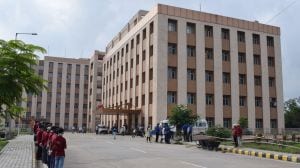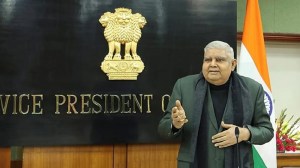From debates to straight-out brawls, Maharashtra Assembly’s steady drift to chaos
With multiple altercations, ministerial outbursts, and a full-blown clash inside the legislature, the current session signals a new low in conduct inside the Maharashtra Assembly.
 The functioning of the Maharashtra Assembly has periodically been marred by episodes of physical and procedural disorder.
The functioning of the Maharashtra Assembly has periodically been marred by episodes of physical and procedural disorder. Legislative assemblies are meant to be sanctums of democracy, where debate and dialogue shape the future of the state. However, over the past two decades, the precincts of the Maharashtra Assembly have increasingly been turned into a battleground, witnessing fistfights between legislators to full-scale brawls between their political supporters.
Thursday’s incident of an outright brawl between the supporters of BJP MLA Gopichand Padalkar and Nationalist Congress Party (Sharad Pawar) MLA Jitendra Awhad in the lobby of the Maharashtra Legislative Assembly has showcased the fragility of legislative decorum, which has been eroding at a fast pace in the state.
Brawls inside the Maharashtra Assembly
The functioning of the Maharashtra Assembly has periodically been marred by episodes of physical and procedural disorder. While Maharashtra’s legislature is deemed institutionally robust, with MLAs known for following procedural norms, the situation seems to have deteriorated substantially, particularly over the last two decades.
The most talked about incident took place on August 12, 1964, when Forward Bloc’s MLA Jambuwantrao Dhote, after being ordered to leave the House by Speaker Balasaheb Bharde, threw a glass paperweight at the latter’s chair. For this display of anger and defiance, the Assembly expelled him permanently, a rare and drastic disciplinary action.
Since then, the Assembly has witnessed aggressive and unparliamentary behaviour multiple times. However, even during the peak of the Shiv Sena’s aggressive streak, proceedings both inside and outside the Maharashtra Legislative Assembly rarely saw outbreaks of violence.
This streak, however, was broken on November 10, 2009, when Samajwadi Party MLA Abu Azmi, who took his oath in Urdu instead of Marathi, was assaulted inside the well of the House by Maharashtra Navnirman Sena (MNS) legislators.
Subsequently, in March 2013, assistant police inspector Sachin Suryavanshi, who had fined Kshitij Thakur, the then MLA of Bahujan Vikas Aghadi, for speeding, was attacked inside the Vidhan Bhavan by a group of legislators. At least three MLAs were reported to have slapped and punched the officer for nearly 10 minutes. The assault occurred after Suryavanshi appeared in the Assembly during a breach-of-privilege motion filed against him. He was dragged from the visitors’ gallery and beaten in the corridor. The incident caused a major rift with the Mumbai police, who surrounded the Assembly premises in an attempt to arrest the offending legislators. A confrontation was, however, averted and most of the MLAs went scot-free.
Present Assembly session: the most controversial
The ongoing Maharashtra Assembly session has been one of the nastiest in recent memory, with MLAs and ministers forgetting civility and their supporters being brazen enough to fight inside the precincts.
The three-week-long session had numerous instances where ministers, including Shambhuraj Desai, lost their cool while replying to questions raised by Opposition MLAs. The behaviour of legislators, their staff, and supporters has also been questionable. Shiv Sena (UBT) MLA Varun Sardesai, in front of television cameras, got into a confrontation with the staff of the Deputy Chairperson of the Maharashtra Legislative Council and Shiv Sena leader Neelam Gorhe, accusing them of deliberately shoving him twice.
The Gopichand Padalkar–Jitendra Awhad feud has also been simmering for the last three days. Padalkar, known for his acerbic tongue and constant stream of allegations against Sharad Pawar, was called a “mangalsutra thief” by Awhad three days ago inside the Assembly premises. A day later, the two had a tiff after Awhad and his supporters alleged that Padalkar deliberately banged his car door forcefully against Awhad while getting out of his vehicle. This feud subsequently escalated into violence between their supporters inside the Assembly on Thursday.
What explains this behaviour
Legal and procedural protections play a role in allowing MLAs to brazen it out. Article 194 of the Constitution grants certain privileges to MLAs, including freedom of speech in the Assembly, immunity from legal proceedings for anything said or voted on inside the House, and protection from arrest in civil cases during the session and 40 days before and after.
However, this protection does not extend to criminal acts such as assault, battery, or criminal intimidation. Before the police take action during an Assembly session, the Speaker’s permission is often sought as a courtesy, especially in the case of sitting legislators. However, action is rarely taken against MLAs for criminal violations inside the Assembly premises. While their supporters are liable for criminal action for violence undertaken inside the Assembly, MLAs generally avoid facing legal consequences.
The only real fear legislators face is the threat of suspension from the House. Even that does not seem to be very effective.
Since the establishment of the Maharashtra Assembly in 1960, the Speaker has suspended 333 legislators for misconduct within the House. However, only 172 of them, roughly 52 per cent, have served their full suspension period, with the Assembly frequently revoking its decisions before the punishment is completed. In recent decades, the state has become increasingly lenient in reversing suspensions. Since 1999, as many as 137 MLAs have been suspended, but nearly 85 per cent of these suspensions (116 MLAs) were later revoked.
The revocation of suspensions is a more recent trend. Prior to 1999, the Speaker took a more rigid approach, ensuring that suspended members served their full punishment. Between 1960 and 1999, as many as 196 MLAs were suspended, with only 21 per cent (44 legislators) having their suspensions revoked.
According to the Rules of Procedure and Conduct of Business in the Lok Sabha, which serve as a template for most state assemblies in India, a legislator can be suspended for disregarding the authority of the Chair.
“The Speaker may, if he deems it necessary, name a member who disregards the authority of the Chair or abuses the rules of the House by persistently and wilfully obstructing the business thereof. (2) If a member is so named by the Speaker, the Speaker shall, on a motion being made, forthwith put the question that the member (naming such member) be suspended from the service of the House for a period not exceeding the remainder of the session,” the rules state.












